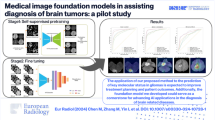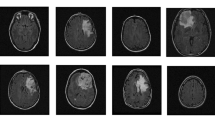Abstract
Brain tumors are among the deadliest diseases in the world. Early diagnosis thereby improves the patient's prospects and likelihood of recovery. It takes a lot of work to separate cancer from other brain abnormalities from MRI images. Various approaches have been devised to predict and divide the tumor. Choosing the finest feature extractor, the long run-time need, and the necessity for expert support are just a few of the challenges they encounter. Improved U-Net and a White Shark aided Beluga Whale Optimization based DCNN are introduced to segment and classify brain tumors (WSBWO based DCNN) into four stages in order to address such concerns. This work uses an improved U-Net based image segmentation model, and the first step of MF based preprocessing uses the input image. The third stage is feature extraction, when statistical features such as I-GBP and MTH are extracted. Subsequently, the DCNN classification system trained on WSBWO is used to classify brain tumors. To validate the suggested work over alternative approaches, various studies were finally carried out.








Similar content being viewed by others
Data availability
The dataset is BraTS, available at https://www.kaggle.com/datasets/dschettler8845/brats-2021-task1.
Abbreviations
- MRI:
-
Magnetic Resonance Imaging
- KNN:
-
K-Nearest Neighbor
- SVM:
-
Support Vector Machine
- DT:
-
Decision Tree
- CNN:
-
Convolutional Neural Network
- GLCM:
-
Gray-Level Co-Occurrence Matrix
- FCM:
-
Fuzzy C-Means
- GHFC:
-
Gaussian Hybrid Fuzzy Clustering
- RBNN:
-
Radial Basis Neural Network
- MRG:
-
Modified Region Growing
- GOA:
-
Grasshopper Optimization Algorithm
- ASVM:
-
Adaptive Support Vector Machine
- BAFCOM:
-
Bat Algorithm with Fuzzy C-Ordered Means
- ECN:
-
Enhanced Capsule Networks
- ANN:
-
Artificial Neural Network
- DNN:
-
Deep Neural Network
- KPCA:
-
Kernel principal component analysis
- MLE:
-
Maximum Likelihood Estimation
- DL:
-
Deep Learning
- ROI:
-
Region Of Interest
- ML :
-
Machine Learning
- BCE:
-
Binary Cross Entropy
- MF:
-
Median Filtering
- MTH:
-
Multi-Texton Histogram
- SD:
-
Standard Deviation
- DCNN:
-
Deep Convolutional Neural Network
- RF:
-
Random Forest
- NRA:
-
Noise Removal Algorithm
- RNN:
-
Recurrent Neural Network
- LSTM:
-
Long Short Term Memory
References
Raja PS (2020) Brain tumor classification using a hybrid deep autoencoder with Bayesian fuzzy clustering-based segmentation approach. Biocybern Biomed Eng 40(1):440–453
Ahuja S, Panigrahi BK, Gandhi TK (2022) Enhanced performance of Dark-Nets for brain tumor classification and segmentation using colormap-based superpixel techniques. Mach Learn Appl 15(7):100212
Luo Z, Jia Z, Yuan Z, Peng J (2020) HDC-Net: Hierarchical decoupled convolution network for brain tumor segmentation. IEEE J Biomed Health Inform 25(3):737–745
Kumar S, Mankame DP (2020) Optimization driven deep convolution neural network for brain tumor classification. Biocybern Biomed Eng 40(3):1190–1204
Dang K, Vo T, Ngo L, Ha H (2022) A deep learning framework integrating MRI image preprocessing methods for brain tumor segmentation and classification. IBRO Neurosci Rep 1(13):523–532
Kumar DM, Satyanarayana D, Prasad MG (2021) An improved Gabor wavelet transform and rough K-means clustering algorithm for MRI brain tumor image segmentation. Multimed Tools Appl 80(5):6939–6957
Shivhare SN, Kumar N (2021) Tumor bagging: a novel framework for brain tumor segmentation using metaheuristic optimization algorithms. Multimed Tools Appl 80(17):26969–26995
Chahal PK, Pandey S (2023) A hybrid weighted fuzzy approach for brain tumor segmentation using MR images. Neural Comput Appl 35(33):23877–23891
Rajasree R, Columbus CC, Shilaja C (2021) Multiscale-based multimodal image classification of brain tumor using deep learning method. Neural Comput Appl 33(11):5543–5553
Sheela CJ, Suganthi GJ (2020) Morphological edge detection and brain tumor segmentation in Magnetic Resonance (MR) images based on region growing and performance evaluation of modified Fuzzy C-Means (FCM) algorithm. Multimed Tools Appl 79(25):17483–17496
Yaganteeswarudu A (2020) Multi disease prediction model by using machine learning and flask API. In: 2020 5th international conference on communication and electronics systems (ICCES). IEEE, pp 1242–1246
Takács P, Kovács L, Manno-Kovacs A (2021) A fusion of salient and convolutional features applying healthy templates for MRI brain tumor segmentation. Multimed Tools Appl 80(15):22533–22550
Akkem Y, Biswas SK, Varanasi A (2023) Smart farming monitoring using ML and MLOps. International conference on innovative computing and communication. Springer Nature Singapore, Singapore, pp 665–675
Farahani A, Mohseni H (2021) Medical image segmentation using customized U-Net with adaptive activation functions. Neural Comput&Applic 33:6307–6323. https://doi.org/10.1007/s00521-020-05396-3
Agrawal P, Katal N, Hooda N (2022) Segmentation and classification of brain tumor using 3D-UNet deep neural networks. Int J Cogn Comput Eng 1(3):199–210
Pitchai R, Supraja P, Victoria AH, Madhavi MJ (2021) Brain tumor segmentation using deep learning and fuzzy K-means clustering for magnetic resonance images. Neural Process Lett 53:2519–2532
Ramesh S, Sasikala S, Paramanandham N (2021) Segmentation and classification of brain tumors using modified median noise filter and deep learning approaches. Multimed Tools Appl 80(8):11789–11813
Sathish P, Elango NM (2022) Gaussian hybrid fuzzy clustering and radial basis neural network for automatic brain tumor classification in MRI images. Evol Intell 15(2):1359–1377
Srinivasa Reddy A, Chenna RP (2021) MRI brain tumor segmentation and prediction using modified region growing and adaptive SVM. Soft Comput 25(5):4135–4148
Ali M, Gilani SO, Waris A, Zafar K, Jamil M (2020) Brain tumour image segmentation using deep networks. IEEE Access 20(8):153589–153598
Alhassan AM, Zainon WM (2020) BAT algorithm with fuzzy C-ordered means (BAFCOM) clustering segmentation and enhanced capsule networks (ECN) for brain cancer MRI images classification. IEEE Access 4(8):201741–201751
Barzegar Z, Jamzad M (2020) A reliable ensemble-based classification framework for glioma brain tumor segmentation. Signal Image Video Process 14(8):1591–1599
Farajzadeh N, Sadeghzadeh N, Hashemzadeh M (2023) Brain tumor segmentation and classification on MRI via deep hybrid representation learning. Expert Syst Appl 224:119963
Al-Zoghby AM, Al-Awadly EMK, Moawad A, Yehia N, Ebada AI (2023) Dual Deep CNN for Tumor Brain Classification. Diagnostics 13(12):2050
G George, RM Oommen, S Shelly, SS Philipose, AM Varghese (2018) "A Survey on Various Median Filtering Techniques For Removal of Impulse Noise From Digital Image," 2018 Conference on Emerging Devices and Smart Systems (ICEDSS), Tiruchengode, India. 235–238. https://doi.org/10.1109/ICEDSS.2018.8544273
Shan B, Fang Y (2020) A Cross Entropy Based Deep Neural Network Model for Road Extraction from Satellite Images. Entropy 22:535. https://doi.org/10.3390/e22050535
ErdalSivri SK (2013) Global binary patterns: a novel shape descriptor. In: MVA2013 IAPR international conference on machine vision applications, Kyoto
Wang H, Hong M (2019) Online ad effectiveness evaluation with a two-stage method using a Gaussian filter and decision tree approach. Electron Commer Res Appl 1(35):100852
Xie S, Shan S, Chen X, Chen J (2010) Fusing local patterns of Gabor magnitude and phase for face recognition. IEEE Trans Image Process 19(5):1349–1361
Liu G-H, Zhang L, Hou Y-K, Li Z-Y, Yang J-Y (2010) Image retrieval based on multi-texton histogram. Pattern Recogn 43(7):2380–2389. https://doi.org/10.1016/j.patcog.2010.02.012
M. Momeny, M.A. Sarram, A.M. Latif, R. Sheikhpour, Y.D. Zhang, A Noise Robust Convolutional Neural Network for Image Classification, Results in Engineering, https://doi.org/10.1016/j.rineng.2021.100225
Zhonga C, Lia G, Mengb Z Beluga whale optimization: A novel nature-inspired metaheuristic algorithm
Braik M, Hammouri A, Atwan J, Al-Betar MA, Awadallah MA (2022) White shark optimizer: a novel bio-inspired meta-heuristic algorithm for global optimization problems. Knowl-Based Syst 11(243):108457
Funding
This research did not receive any specific funding.
Author information
Authors and Affiliations
Corresponding author
Ethics declarations
Ethical approval
Not Applicable.
Informed consent
Not Applicable.
Conflict of interest
The authors declare no conflict of interest.
Additional information
Publisher's Note
Springer Nature remains neutral with regard to jurisdictional claims in published maps and institutional affiliations.
Rights and permissions
Springer Nature or its licensor (e.g. a society or other partner) holds exclusive rights to this article under a publishing agreement with the author(s) or other rightsholder(s); author self-archiving of the accepted manuscript version of this article is solely governed by the terms of such publishing agreement and applicable law.
About this article
Cite this article
Kusuma, P.V., Reddy, S.C.M. MRI Brain tumor segmentation and classification with improved U-Net model. Multimed Tools Appl (2024). https://doi.org/10.1007/s11042-024-18893-7
Received:
Revised:
Accepted:
Published:
DOI: https://doi.org/10.1007/s11042-024-18893-7




